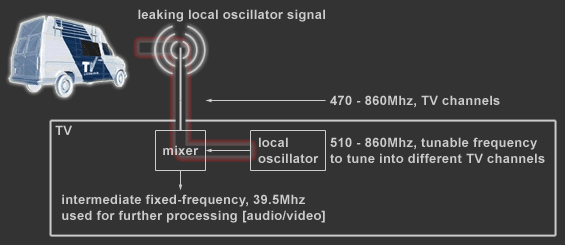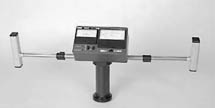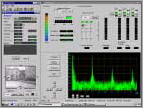|
ABOUT TV DETECTOR VANS & DETECTION |
|||||||||||||
|
HOME CUISINE ENVIRONMENT INSURANCE HORSES LEGENDS LAW NEWS PRODUCE RIGHTS SITE INDEX TRANSPORT WHISTLEBLOWING |
|||||||||||||
|
BBC
RESISTANCE | www.tvlicensing.biz | www.bbcresistance.co.uk
www.bbcresistance.com TV detection: Science Fact or Fiction
The
TVLA/BBC/Capita's website [www.tvlicensing.co.uk] states the following on
TV detection: "we can detect a TV in use, in any area. That's because
every TV contains a component called the 'local oscillator', which emits a
signal when the television is switched on. It's this signal that the
external aerials on our vans pick up." It also states that hand-held
scanner are used to locate television sets in hard to reach places.
The frequency of the local oscillator is always 39.5Mhz above the channel received. In other words; the leaking local oscillator signal tells not only whether a TV is switched on or not but it also reveals what channel is being watched. The following formula gives an indication of the channel watched:
TV channel detection examples Example 1. The [leaked] oscillator signal received is 793.75Mhz. According the formula the frequency of the TV signal tuned into is as follow: 754.25Mhz = 793.75Mhz - 39.5Mhz 754.25Mhz is within the nationwide channel 56 [751.25Mhz - 757.25Mhz] which happens to be BBC1 Example 2. The [leaked] oscillator signal received is 841.75Mhz. According the formula the frequency of the TV signal tuned into is as follow: 802.25Mhz = 841.75Mhz - 39.5Mhz 802.25Mhz is within the nationwide channel 62 [799.25Mhz - 805.25Mhz] which happens to be BB
A TV is also pretty noisy at other frequencies; there is considerable radiation from the timebase scanning coils. These are driven by a pulsed signal at 14.625Khz and so splatter characteristic higher frequency harmonics into the ether. They can easily be detected with a long-wave radio near the TV. The picture below shows three TV set-ups and their point of 'leakage'.
BBC Research & Development, Tadworth Surrey [a frequent visitor of this website] is involved in the development of television detection equipment. The picture below shows a 1997 prototype hand-held television detector unit.
In the annual review report of March 2002 the BBC Research & Development department claims the following on their latest technological achievements to catch TV Licence dodgers: "... The new equipment is controlled by a computer, which presents a very user-friendly interface to the operator. The detection results and all relevant data are recorded automatically. We have added a satellite based live map navigation system which helps minimise the time spent travelling between sites, as well as an automated database showing receivable transmitters at the vanís location.
The equipment can show which transmitter is being received, and which channel is being viewed. The van will be in frequent contact with TV Licensing Unitís database to check whether the viewer has a current licence. All of the equipment is contained within the van without exterior aerials. This offers the choice of covert operation, or alternately of high-profile operation simply by emblazoning the van with an appropriate logo. We are working with BBC Technology to produce a fleet of vans with the new equipment; meanwhile, the development and testing of a further detection method nears completion. Portable detection equipment includes a handheld magnetic detector designed for use where van access is impracticable, and a shirt-pocket equivalent for covert operation."
A TV Detection display screen showing computer generated graphs.
It is BBC Research & Development, in conjunction with Capita, to select a company to take prototype equipment into production. Click any of the pictures below addressing TV Detection vans.
Despite all of the expensive gadgets developed by BBC R&D detection of TV Licence evasion depends heavily on an address based system [database called "Lassy"], so if you're not on their supposedly exhaustive list, they nip round, listen really carefully at the door and bust you if they hear Anne Robinson's voice.
Another way of telling someone has got a TV is by aerial spotting. Apparently there is this story about a tv detector man claiming someone had a tv because of the aerial, the man then replied "just cos' I've got milk on me door step doesn't mean I've got a cow."
In addition to the Lassy database, the TVLA/Capita has a database called the Campaign Management Data Warehouse [CMDW]. The CMDW holds records of recent "customer" contacts and demographic information on Postcodes, obtained from third parties. This information is held and used for the purpose of segmentation of mailing activity. For example if a certain postcode is likely to contain student residences, then a special targeted letter, might be mailed to address in the postcode area.
The
National
Audit Office Report of May 2002 [PDF file, 792K] states the
following on detector vans: "the BBC is introducing new detector vans
with enhanced capabilities to detect when a television is in use. This
will make it easier for enquiry officers to establish that an offence is likely
to be taking place, although they will still need to secure further
evidence for successful prosecution. Detection equipment has been used
in conjunction with targeted advertising to act as a visible
deterrent."
TEMPEST [looking beyond the local oscillator]
This
is where we step into the twilight zone. Not sure if the TVLA has 'toys'
to be this intrusive ... TEMPEST [Telecommunications Electronics Material
Protected From Emanating Spurious Transmissions] is an U.S. government
code word that identifies a classified set of standards for limiting
electric or electromagnetic radiation emanations from electronic
equipment. Microchips, monitors, printers, and all electronic devices emit
radiation through the air or through conductors [such as wiring or water
pipes].
Electromagnetic Radiation from Video Display Units: An Eavesdropping Risk? This is Van Eck's paper [in PDF-format] that brought emanation monitoring to the public's attention. It's pretty technical stuff.
With thanks to Action Groups across the country for the supply of real case history and supporting documents. *THAT THE PUBLIC MAY KNOW*
|
|||||||||||||
|
This site is free of © Copyright except where specifically stated. Any person may download, use and quote any reference or any link, and is guaranteed such right to freedom of information and speech under the Human Rights and Freedom of Information Acts. However, be aware that we cannot be held liable for the accuracy of the information provided. All users should therefore research matters for themselves and seek their own legal advice and this information is provided simply by way of a guide. Horse Sanctuary UK Limited. All trademarks herby acknowledged. |
|||||||||||||







